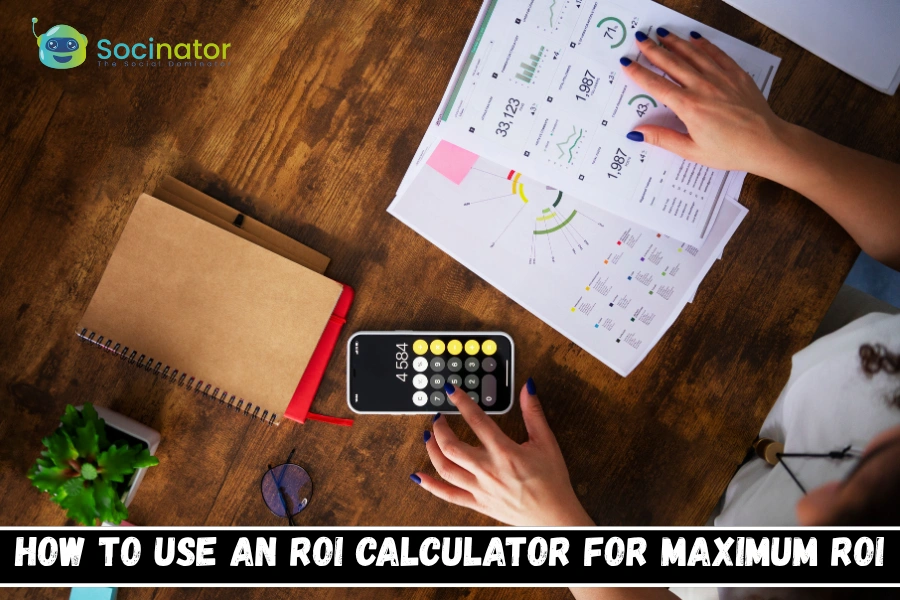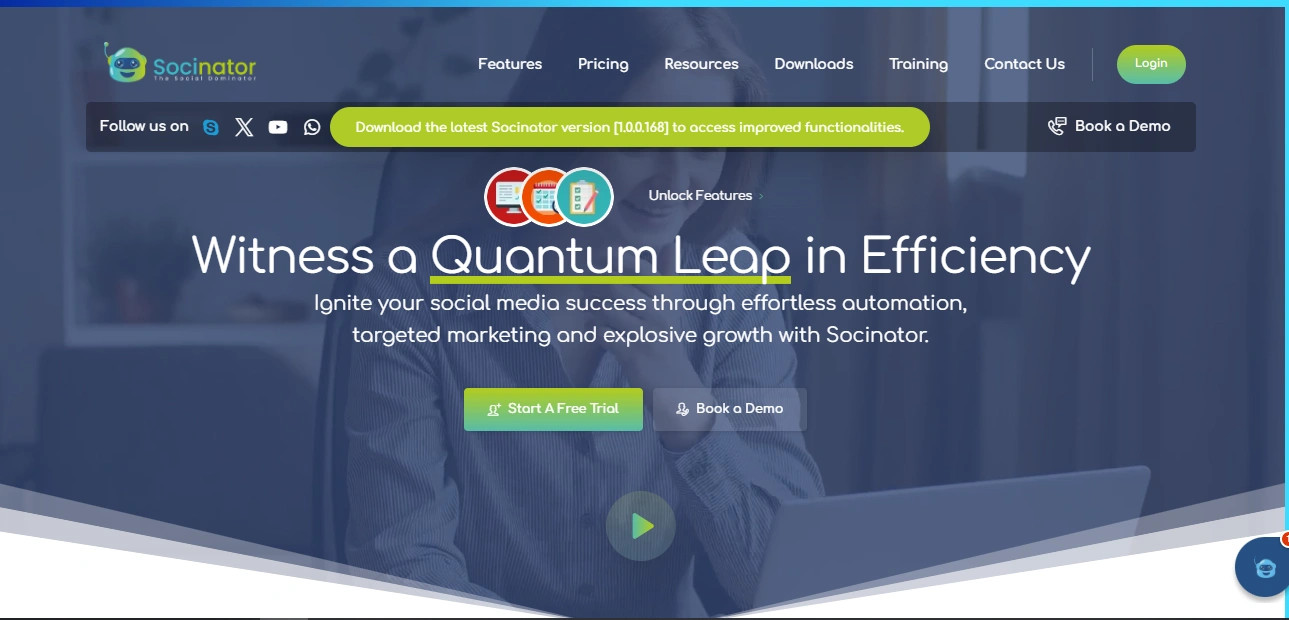In today’s competitive business environment, every marketing dollar counts. Companies no longer rely solely on intuition or guesswork when evaluating their campaigns. Instead, they turn to data-driven solutions like an ROI calculator to understand how their investments translate into measurable results. An ROI calculator is a powerful tool that helps businesses track the effectiveness of their marketing initiatives, optimize resource allocation, and maximize profitability.
In this guide, we’ll explore what an ROI calculator is, how it works, the benefits of using it, and how various industries can implement it to achieve better returns.
In a hurry? Listen to the blog instead!
What Is An ROI Calculator?
An ROI calculator is a digital tool or formula used to measure the return on investment (ROI) of a specific activity, project, or marketing campaign. It evaluates the effectiveness of your investments by comparing the gains generated against the costs incurred.
The formula for calculating ROI is straightforward:
ROI (%) = (Net Profit ÷ Cost of Investment) × 100
Here, the net profit is the revenue generated from a specific campaign minus the total costs associated with it. A higher ROI percentage indicates that your investment is yielding better returns.
Businesses often use ROI calculators for various purposes, such as evaluating marketing campaigns, technology purchases, or operational initiatives. By using this tool, decision-makers can make more informed choices that align with organizational goals.
Why Businesses Need An ROI Calculator?
Many companies struggle to justify their marketing budgets. Without proper analysis, it’s challenging to determine which campaigns are driving results and which are draining resources. An ROI calculator addresses this problem by providing a clear, quantifiable measure of success.
Here are some reasons why businesses need an ROI calculator:
- Measure Campaign Effectiveness: Determine which marketing strategies are delivering the highest returns.
- Allocate Resources Wisely: Identify campaigns worth scaling and those that need optimization.
- Data-Driven Decisions: Replace guesswork with analytics-backed insights.
- Track Long-Term Performance: Monitor ROI over time to adjust strategies as needed.
- Demonstrate Value to Stakeholders: Present clear metrics to justify investments to executives and investors.
Incorporating an ROI calculator into your small business marketing strategy allows companies to focus on activities that contribute directly to business growth and profitability.
What Are The Different Types Of ROI Calculators?
ROI calculators can vary based on the type of investment being analyzed. Here are the most common types of ROI calculators used in businesses today:
1. Marketing ROI Calculator:
A marketing ROI calculator helps evaluate the performance of marketing campaigns across different channels. By analyzing data from digital ads, email marketing, social media, and other channels, businesses can pinpoint which strategies generate the best returns.
Metrics considered in a marketing ROI calculator include:
- Campaign costs (ad spend, content creation, software tools)
- Revenue generated from leads and conversions
- Customer acquisition costs (CAC)
- Customer lifetime value (CLV)
By calculating the ROI of marketing campaigns, businesses can optimize their marketing budgets and improve overall performance.
2. Website ROI Calculator:
A website ROI calculator is designed to measure the effectiveness of a website in generating leads and driving revenue. A website is often the first point of contact between a brand and its potential customers, making it critical to track its performance.
Key elements of a website ROI calculator include:
- Conversion rates for landing pages or forms
- Traffic sources (organic, paid, referral)
- Cost of website development and maintenance
- Revenue generated from online transactions or leads
Using a website ROI calculator, businesses can identify areas of improvement on their website, such as optimizing page design, improving user experience, or enhancing call-to-action strategies.
3. Content Marketing ROI Calculator:
Content marketing is an essential part of modern marketing strategies. A content marketing ROI calculator helps assess the return on investment for blog posts, videos, infographics, and social media content.
Metrics tracked include:
- Cost of content creation and promotion
- Engagement metrics (likes, shares, comments)
- Lead generation and conversions from content
- Revenue attributable to content campaigns
With a content marketing ROI calculator, companies can determine which content resonates most with their audience and which strategies generate tangible revenue.
Also Read:
How To Maximize Your Content Marketing ROI?
The Ultimate Guide To Small Business Marketing
4. Marketing Automation ROI Calculator:
Marketing automation is becoming increasingly popular for streamlining repetitive marketing tasks. A marketing automation ROI calculator measures the value generated by automation tools in terms of efficiency, cost savings, and revenue growth.
Metrics for this calculator often include:
- Cost of marketing automation software
- Time saved on repetitive tasks
- Revenue generated from automated campaigns
- Improved lead nurturing and conversion rates
By leveraging a marketing automation ROI calculator, businesses can demonstrate the tangible benefits of adopting automation tools and justify the associated investment.
How To Use An ROI Calculator Effectively?
While an ROI calculator provides valuable insights, its effectiveness depends on how accurately you input data and interpret results. Here’s a step-by-step guide to using an ROI calculator:
Step 1: Define the Objective
Before calculating ROI, clearly define the goal of your investment. Are you evaluating a digital ad campaign, a content strategy, or website development? A well-defined objective ensures you measure relevant metrics.
Step 2: Gather Accurate Data
Collect all relevant data, including:
- Investment costs (time, money, resources)
- Revenue or savings generated from the investment
- Operational costs or overheads related to the project
Accurate data ensures the ROI calculation reflects the real impact of your efforts. Incorporating social media analytics can further enhance accuracy by tracking engagement, conversions, and audience behavior especially if your investment involves digital or social media campaigns.
Step 3: Choose the Right ROI Calculator
Select an ROI calculator suited for your specific purpose. If you’re analyzing a marketing campaign, use a marketing ROI calculator. For website performance, a website ROI calculator will provide more precise insights.
To maximize the ROI of your social media campaigns, consider using an ROI calculator alongside powerful marketing tools like Socinator. Socinator helps streamline your social media workflow, automate posts, and track analytics, giving you precise data that can feed directly into your ROI calculations.
By integrating Socinator with your campaign planning, your social media efforts become not only efficient but also highly measurable.
Step 4: Input Data Carefully
Enter all collected data into the ROI calculator. Double-check numbers to avoid errors that could skew results. Some calculators allow advanced metrics, like customer lifetime value or attribution modeling, which can enhance accuracy.
Step 5: Analyze Results
Once the calculation is complete, analyze the results to determine ROI percentage. A positive ROI indicates the investment generated profit, while a negative ROI signals a loss. Use these insights to guide future strategies.
Step 6: Take Action
The final step is taking action based on ROI insights. Optimize campaigns, reallocate budgets, or discontinue underperforming initiatives. An ROI calculator is only valuable when its results inform actionable business decisions.
How To Maximize Your Social Media ROI Using Socinator?
Running social media campaigns without proper tools can make it challenging to measure ROI accurately. With social media automation tools like Socinator, you can keep track of social media engagement insights. It is an all-in-one social media management software designed to complement and boost your post engagement, allowing you to achieve higher ROI.
Key Features of Socinator:
- Access 9+ Social Media Platforms: Manage multiple accounts in one place, saving time and effort.
- Plan, Schedule & Collaborate: Use the content calendar to organize posts ahead of time, ensuring campaigns run smoothly.
- Track Analytics & Insights: Monitor engagement and performance to feed accurate data into your ROI calculations.
- Automate Social Media Posts: Save time on repetitive tasks while improving consistency across campaigns.
- Audience Targeting & Growth: Reach the right audience, increase conversions, and boost marketing ROI.
- Account Security & Reliability: Safeguard your accounts while managing multiple campaigns efficiently.
With over 5000 users across 100+ companies in 15+ countries, Socinator has proven its effectiveness in helping brands grow without added pressure. By integrating Socinator with your ROI tracking efforts, businesses can streamline workflows, optimize social media strategies, and maximize the return on every marketing investment.
What Are The Key Benefits Of Using An ROI Calculator For Your Business?
Implementing an ROI calculator offers multiple advantages for businesses that want to make smarter, data-driven decisions and achieve measurable growth. Here’s how it can help:
Make Data-Driven Marketing Decisions:
Instead of relying on intuition or assumptions, an ROI calculator provides concrete metrics that guide marketing strategies. This ensures decisions are backed by real performance data, helping businesses focus on campaigns that deliver actual results rather than guesswork.
Optimize Budget Allocation:
An ROI calculator highlights which campaigns generate the highest returns. By identifying these high-performing initiatives, businesses can allocate marketing budgets more effectively, reducing wasted spend and maximizing the impact of every dollar invested.
Enhance Team Accountability:
With clear ROI metrics, each campaign’s success can be tracked precisely. This promotes accountability within marketing teams, allowing managers to evaluate individual contributions, identify areas for improvement, and reward performance fairly.
Communicate Results Effectively to Stakeholders:
ROI figures are straightforward and easy to understand. This clarity allows marketing teams to present campaign performance to stakeholders, executives, investors, or clients, confidently, building trust and demonstrating the value of marketing efforts.
Refine Customer Acquisition Strategies:
By analyzing the ROI of different marketing channels, businesses can determine which approaches attract the most valuable customers at the lowest cost. This insight helps optimize customer acquisition efforts and improve overall profitability.
Support Long-Term Strategic Planning:
Regular ROI monitoring reveals performance trends over time. This historical insight enables businesses to make informed long-term decisions, identify growth opportunities, and develop strategies that maximize both profitability and sustainable growth.
Also Read:
What Is Social Media Analytics | 07 Best Tools To Help You With It
What Are Common Mistakes To Avoid When Using An ROI Calculator?
Even though an ROI calculator is a valuable tool, mistakes in its use can lead to misleading results. Avoid these common pitfalls:
- Ignoring Hidden Costs: Include all expenses related to the investment, not just the obvious ones.
- Focusing Only on Short-Term ROI: Long-term benefits may be missed if only immediate gains are considered.
- Using Inaccurate Data: Poor data quality results in unreliable ROI calculations.
- Neglecting Non-Monetary Benefits: Some initiatives, like brand awareness, may not show immediate financial returns but still hold value.
- Overcomplicating the Calculation: Keep the formula simple to avoid confusion and maintain clarity.
By being aware of these mistakes, businesses can ensure their ROI calculations are accurate and actionable.
Real-World Applications Of An ROI Calculator
An ROI calculator isn’t limited to marketing alone. It can be applied across various business operations:
1. Marketing Campaigns:
Evaluate digital ads, email campaigns, social media marketing, and influencer partnerships to understand which strategies generate the highest returns.
2. Technology Investments:
Measure the return on software purchases, hardware upgrades, or digital tools to determine whether the investment is cost-effective.
3. Training Programs:
Assess the ROI of employee training and development initiatives to ensure resources are spent effectively on skill-building.
4. Operational Projects:
Track ROI for operational improvements, such as process automation or workflow optimization, to verify efficiency gains.
5. Product Launches:
Evaluate the profitability of new products by comparing launch costs to generate revenue, enabling smarter decisions for future releases.
What Are The Key Features To Look For In An ROI Calculator?
Selecting the right ROI calculator ensures accurate measurement of your investments and smarter decision-making. Look for these features:
- Ease of Use
A simple, intuitive interface allows any team member to analyze ROI quickly without a steep learning curve. - Customizable Metrics
Ability to input your unique costs, revenues, and marketing channels for precise, tailored results. - Integration with Analytics Tools
Connects with platforms like Google Analytics, CRM systems, or email tools to automate data collection and reduce errors. - Real-Time Data Analysis
Provides instant insights, helping you spot trends and adjust campaigns quickly. - Advanced Reporting
Generates detailed, easy-to-share reports for stakeholders, showcasing campaign performance clearly.
By prioritizing these features, businesses can select an ROI calculator that not only measures performance accurately but also empowers smarter decision-making and efficient resource allocation.
How ROI Calculators Enhance Digital Marketing?
In the digital marketing world, tracking ROI is more critical than ever. Digital channels are diverse, from social media ads to email campaigns, each with unique costs and results. An ROI calculator helps marketers:
- Measure performance across multiple channels
- Compare organic vs. paid campaigns
- Optimize ad spend for maximum conversions
- Identify underperforming strategies
- Justify marketing budgets with tangible results
A digital marketing team that leverages an ROI calculator can make smarter decisions, allocate resources effectively, and demonstrate measurable impact to stakeholders.
Tips For Maximizing ROI Using A Calculator
Using an ROI calculator effectively goes beyond entering numbers. Consider these tips to maximize your results:
- Set Clear Goals: Know what you want to achieve before measuring ROI.
- Include All Relevant Metrics: Capture costs, revenue, and indirect benefits for accuracy.
- Regular Monitoring: Analyze ROI regularly rather than relying on a one-time calculation.
- Adjust Strategies Promptly: Use insights to refine campaigns and investments.
- Benchmark Performance: Compare ROI across campaigns or periods to identify trends.
Implementing these practices ensures that your ROI calculations lead to actionable insights and improved performance.
Conclusion
An ROI calculator is more than just a mathematical formula; it’s a strategic tool that empowers businesses to make data-driven decisions, optimize budgets, and achieve better returns on investments. From marketing campaigns to website performance and content strategies, an ROI calculator provides clarity and actionable insights across various aspects of business operations.
By adopting an ROI calculator, companies can focus on initiatives that deliver real value, eliminate guesswork, and drive measurable growth. To take your social media campaigns to the next level and make your ROI calculations even more effective, tools like Socinator offer automation, analytics, and scheduling features that streamline workflows and maximize results.
In an era where every dollar counts, leveraging such a tool is not just smart—it’s essential for sustainable success.
FAQs
1. How is marketing ROI different from general ROI?
Ans. Marketing ROI focuses specifically on the return generated by marketing activities, whereas general ROI can be applied to any investment or project.
2. Can ROI calculators measure long-term benefits?
Ans. Yes, by including projected revenue and customer lifetime value, ROI calculators can estimate long-term gains.
3. Are ROI calculators suitable for small businesses?
Ans. Absolutely. ROI calculators are versatile tools that help businesses of all sizes make informed investment decisions.












